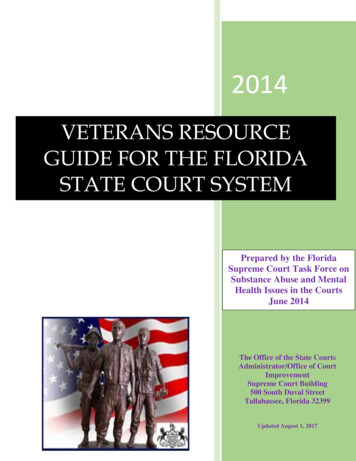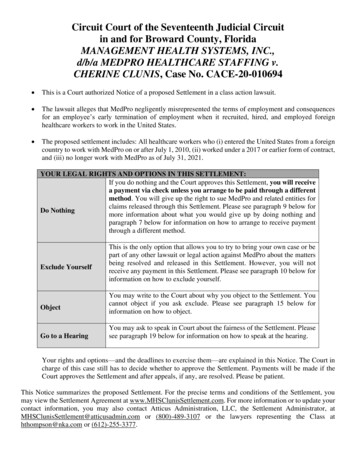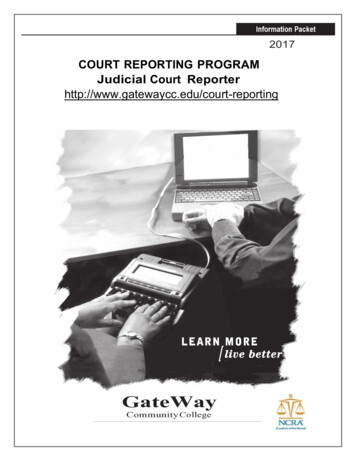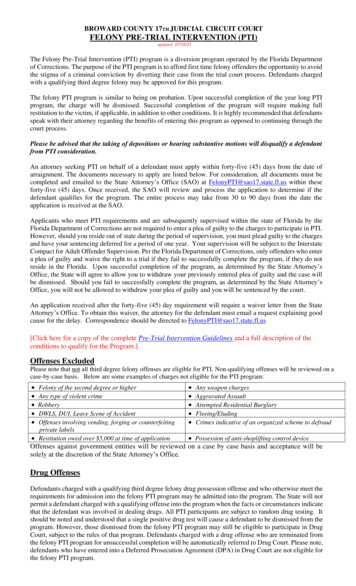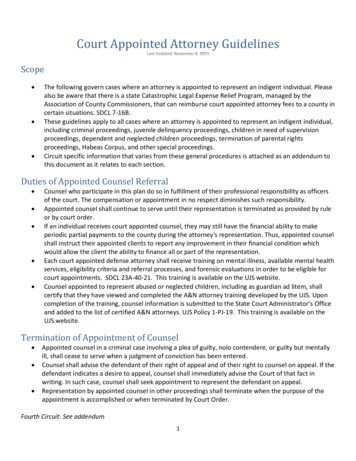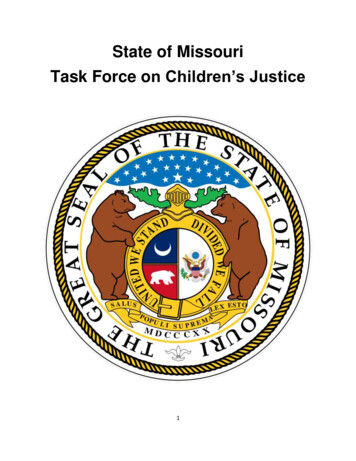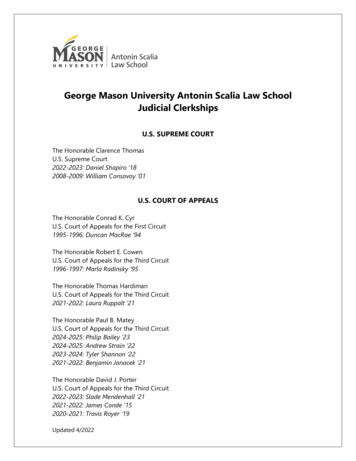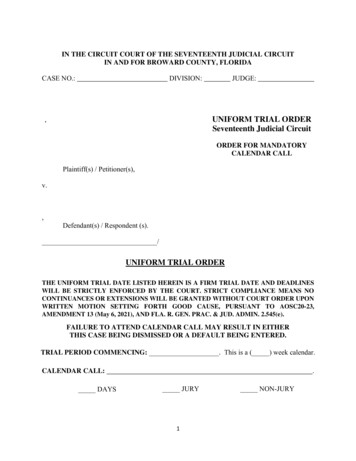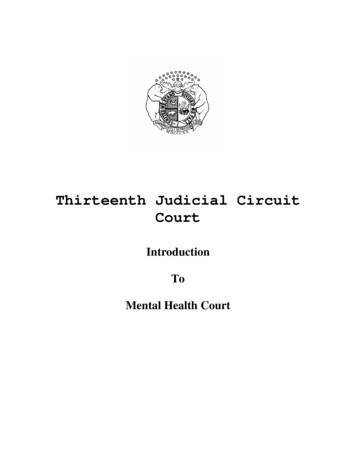
Transcription
Thirteenth Judicial CircuitCourtIntroductionToMental Health Court
THIRTEENTH JUDICIAL CIRCUIT COURTADULT MENTAL HEALTH COURT PROGRAMSPOLICY AND PROCEDURE MANUALTable of ContentsI. History of Mental Health CourtII. Mission Statement and PurposeIII. The 10 Essential Elements of a Mental Health CourtIV. Benefits of Mental Health CourtV. Services OfferedVI. Program OverviewVII. Mental Health Court Program ManuelVIII. Memorandum of UnderstandingIX. Staffing and Docket ProceduresX. Referral to Mental Health Court ProgramsXI. Pre-Plea Diversion Track Eligibility and AdmissionXII. Post-Plea Diversion Track Eligibility and AdmissionXIII. Probation Track Eligibility and AdmissionXIV. Ineligibility and Termination ProceduresXV. Graduation ProceduresAppendix:A.B.C.D.E.F.Eligibility Flow ChartsPolicy and Procedure for Assistant Prosecuting AttorneyPolicy and Procedure for Probation OfficersPolicy and Procedure for Treatment ProvidersParticipant’s HandbookMental Health Court Testing Forms
History of Mental Health CourtIn Missouri as in other states, deinstitutionalization of the mentally ill from stateinstitutions has lead to increased instances of this population being found in the criminaljustice system. Mental Health Courts were developed to deal with this specialpopulation.Boone County’s Mental Health Court was established in response to the increasingnumbers of mentally ill persons found in the local jail population. At the same time, theHonorable Christine Carpenter recognized the challenges by substance-abusing offenderswith mental illness as a co-occuring disorder through her experience presiding overBoone County’s Drug Court.On April 22, 2003, Boone County established a Mental Health Court. This project wascreated to better serve the community by reducing criminalization of persons with mentalillness, and promoting an integrated treatment program. The first docket consisted of twoparticipants.The Mental Health Court is a voluntary program that includes regular court appearancesbefore the Mental Health Court Judge. Participants in Mental Health Court also have togo to treatment, which includes individual counseling, group counseling, and regular drugtesting. The length of the Mental Health Court Program is determined by eachparticipant’s progress, with a minimum of one year and a maximum of two years.The Mental Health Court received its initial funding from a federal grant from the Bureauof Justice Administration. This grant was for two years, and was extended throughNovember 2006. Also, funding will be sustained with help of Boone County’s speciallaw enforcement tax, Proposition “L”. Other services that are provided by Mental HealthCourt are paid by a variety of sources: the participant’s private insurance, participant’sMedicaid and the Missouri Department of Mental Health.
Mission StatementThe mission of the Mental Health Court is to address the unique needs of the mentally ill,and the mentally ill with a coexisting disorder of substance abuse, in the criminal justicesystem by serving as a bridge between the criminal justice system and the mental healthsystem, for the benefit of the clients they share.Program PurposeThe purpose of the Mental Health Court program is to improve services to offenders whohave a serious and persistent mental illness, including those offenders with co-occurrngsubstance abuse disorders, by assuring a continuum of care and easy access to mentalhealth services.The court works to increase cooperation between the mental health treatment system andthe criminal justice system to achieve faster case processing time and improved access topublic mental health treatment services, with the larger objectives of reducing thecriminalization of persons with mental illness, reducing recidivism, improving publicsafety, and improving the level of functioning of program participants in society.
THIRTEENTH JUDICIAL CIRCUIT COURTADULT MENTAL HEALTH COURT PROGRAMS10 ESSENTIAL ELEMENTS1. Planning and Administration. A broad-based group of stakeholdersrepresenting the criminal justice, mental health, substance abuse treatment,and related systems and the community guides the planning andadministration of the court.Mental health courts are situated at the intersection of the criminal justice, mental health,substance abuse treatment, and other social service systems. Their planning andadministration should reflect extensive collaboration among practitioners andpolicymakers from those systems, as well as community members. To that end, amultidisciplinary“planning committee” should be charged with designing the mentalhealth court. Along with determining eligibility criteria, monitoring mechanisms, andother court processes, this committee should articulate clear, specific, and realizable goalsthat reflects agreement on the court’s purposes and provide a foundation for measuringthe court’s impact (see Element 10: Sustainability). Ideally, the development of a mentalhealth court should take place in the context of broader efforts to improve the response topeople with mental illnesses involved with, or at risk of involvement with, lawenforcement, the courts, and corrections. Such discussions should include police andsheriffs’ officials, judges, prosecutors, defense counsel, court administrators, pretrialservices staff, and corrections officials; mental health, substance abuse treatment,housing, and other service providers; and mental health advocates, crime victims,consumers, and family and community members. The planning committee shouldidentify agency leaders and policymakers to serve on an “advisory group” (in somejurisdictions members of the advisory group will also make up the planning committee),responsible for monitoring the court’s adherence to its mission and its coordination withrelevant activities across the criminal justice and mental health systems. The advisorygroup should suggest revisions to court policies and procedures when appropriate, andshould be the public face of the mental health court in advocating for its support.The planning committee should address ongoing issues of policy implementation andpractice that the court’s operation raises. Committee members should also keep highlevel policymakers, including those on the advisory group, informed of the court’ssuccesses and failures in promoting positive change and long-term sustainability (seeElement 10). Additionally, by facilitating ongoing training and education opportunities,the planning committee should complement and support the small team of professionalswho administer the court on a daily basis, the “court team” (see Element 8). In manyjurisdictions, the judiciary will ultimately drive the design and administration of themental health court. Accordingly, it should be well represented on and take a visible rolein leading both the planning committee and advisory group.2. Target Population. Eligibility criteria address public safety and consider acommunity’s treatment capacity, in addition to the availability of alternatives
to pretrial detention for defendants with mental illness. Eligibility criteriaalso take into account the relationship between mental illness and adefendant’s offenses, while allowing the individual circumstances of eachcase can be considered.Because mental health courts are, by definition, specialized interventions that can serveonly a portion of defendants with mental illness, careful attention should be paid todetermining their target populations. Mental health courts should be conceptualizedas part of a comprehensive strategy to provide law enforcement, court, and correctionssystems with options, other than arrest and detention, for responding to people withmental illnesses. Such options include specialized police-based responses and pretrialservices programs. For those individuals who are not diverted from arrest or pretrialdetention, mental health courts can provide appropriately identified defendants withcourt-ordered, community-based supervision and services. Mental health courts should beclosely coordinated with other specialty or problem-solving court-based interventions,including drug courts and community courts, as target populations are likely to overlap.Clinical eligibility criteria should be well defined and should be developed with anunderstanding of treatment capacity in the community. Mental health court personnelshould explore ways to improve the accessibility of community-based care whentreatment capacity is limited and should explore ways to improve quality of care whenservices appear ineffective (see Element 6: TreatmentSupports and Services). Mental health courts should also focus on defendants whosemental illness is related to their current offenses. To that end, the planning committeeshould develop a process or a mechanism, informed by mental health professionals, toenable staff charged with identifying mental health court participants to make thisdetermination.3. Timely Participant Identification and Linkage to Services. Participants areidentified, referred, and accepted into mental health courts, and then linkedto community-based service providers as quickly as possible.Providing safe and effective treatment and supervision to eligible defendants in thecommunity, as opposed to in jail or prison, is one of the principal purposes of mentalhealth courts. Prompt identification of participants accelerates their return to thecommunity and decreases the burden on the criminal justice system for incarceration andtreatment. Mental health courts should identify potential participants early in thecriminal justice process by welcoming referrals from an array of sources suchas law enforcement officers, jail and pretrial services staff, defense counsel, judges, andfamily members. To ensure accurate referrals, mental health courts must advertiseeligibility criteria and actively educate these potential sources. In addition to creatinga broad network for identifying possible participants, mental health courts should selectone or two agencies to be primary referral sources that are especially well versed in theprocedures and criteria. The prosecutor, defense counsel, and a licensed clinician shouldquickly review referrals for eligibility. When competency determination isnecessary, it should be expedited, especially for defendants charged with misdemeanors.The time required to accept someone into the program
should not exceed the length of the sentence that the defendant would have received hadhe or she pursued the traditional court process. Final determination of eligibility shouldbe a team decision (see Element 8: Court Team). The time needed to identify appropriateservices, the availability of which may be beyond the court’s control, may constrainefforts to identify participants rapidly (see Element 6: Treatment Supportsand Services). This is likely to be an issue especially in felony cases, when the court mayseek services of a particular intensity to maximize public safety. Accordingly, along withconnecting mental health court participants to existing treatment, officials in criminaljustice, mental health, and substance abuse treatment should work together toimprove the quality and expand the quantity of available services.4. Terms of Participation. Terms of participation are clear, promote publicsafety, facilitate the defendant’s engagement in treatment, are individualizedto correspond to the level of risk that the defendant presents to thecommunity, and provide for positive legal outcomes for those individualswho successfully complete the program.Mental health courts need general program parameters for plea agreements, programduration, supervision conditions, and the impact of program completion. Within theseparameters, the terms of participation should be individualized to each defendant andshould be put in writing prior to his or her decision to enter the program. The terms ofparticipation will likely require adherence to a treatment plan that will be developed afterengagement with the mental health court program, and defendants should be made awareof the consequences of noncompliance with this plan. Whenever plea agreements areoffered to people invited to participate in a mental health court, the potential effects of acriminal conviction should be explained. Collateral consequences of a criminalconviction may include limited housing options, opportunities for employment, andaccessibility to some treatment programs. It is especially important that the defendant bemade aware of these consequences when the only charge he or she is facing is amisdemeanor, ordinance offense, or other nonviolent crime. The length of mental healthcourt participation should not extend beyond the maximum period ofincarceration or probation a defendant could have received if found guilty in a moretraditional court process. In addition, program duration should vary depending on adefendant’s program progress. Program completion should be tied to adherence to theparticipant’s court-ordered conditions and the strength of his or her connection tocommunity treatment. Least restrictive supervision conditions should be considered forall participants, especially those charged with misdemeanors. Highly restrictiveconditions increase the likelihood that minor violations will occur, which can intensifythe involvement of participants in the criminal justice system. When a mental healthcourt participant completes the terms of his or her participation in the program, thereshould be some positive legal outcome. When the court operates on a pre-plea model, asignificant reduction or dismissal of charges can be considered. When the court operatesin a post-plea model, a number of outcomes are possible such as early terminations ofsupervision, vacated pleas, and lifted fines and fees. Mental health courtparticipants, when in compliance with the terms of their participation, should have theoption to withdraw from the program at any point without having their prior participation
and subsequent withdrawal from the mental health court reflect negatively on theircriminal case.5. Informed Choice. Defendants fully understand the program requirementsbefore agreeing to participate in a mental health court. They are providedlegal counsel to inform this decision and subsequent decisions about programinvolvement. Procedures exist in the mental health court to address, in atimely fashion, concerns about defendant’s competency whenever they arise.Defendants’ participation in mental health courts is voluntary. But ensuring thatparticipants’ choices are informed, both before and during the program, requires morethan simply offering the mental health court as an option to certain defendants. Mentalhealth court administrators should be confident that prospective participants arecompetent to participate. Typically, competency determination procedures can belengthy, which raises challenges for timely participant identification. This is especiallyimportant for courts that focus on defendants charged with misdemeanors (see Element3: Timely Participant Identification and Linkage to Services). For these reasons, as partof the planning process, courts should develop guidelines for the identification andexpeditious resolution of competency concerns. Even when competency is not an issue,mental health court staff must ensure that defendants fully understand the terms ofparticipation, including the legal repercussions of not adhering to program conditions.The specific terms that apply to each defendant should be spelled out in writing.Defendants should have the opportunity to review these terms, with the advice ofcounsel, before opting into the court. Defense attorneys play an integral role in helpingto ensure that defendants’ choices are informed throughout their involvement in themental health court. Admittedly, the availability of defense counsel varies from onejurisdiction to another. In some communities, defendants’ access to counsel depends onthe crime with which they were charged or the purpose of the hearing. Recognizing theseconstraints, courts should strive to make defense counsel available to advise defendantsabout their decision to enter the court and have counsel be present at statushearings. It is particularly important to ensure the presence of counsel when there is a riskof sanctions or dismissal from the mental health court. Defense counsel participating inmental health courts—like all other criminal justice staff assigned to the court—should receive special training in mental health issues (see Element 8: Court Team).6. Treatment Supports and Services. Mental health courts connect participantsto comprehensive and individualized treatment supports and services in thecommunity. They strive to use—and increase the availability of—treatmentand services that are evidence-based.Mental health court participants require an array of services and supports, which caninclude medications, counseling, substance abuse treatment, benefits, housing, crisisinterventions services, peer supports, and case management. Mental health courts shouldanticipate the treatment needs of their target population and work with providers toensure that services will be made available to court participants. When a participant isidentified and linked to a service provider, the mental health court team should design atreatment plan that takes into account the results of a complete mental health and
substance abuse assessment, individual consumer needs, and public safety concerns.Participants should also have input into their treatment plans. A large proportion ofmental health court participants have co-occurring substance abuse disorders.The most effective programs provide coordinated treatment for both mental illnesses andsubstance abuse problems. Thus, mental health courts should connect participants withco-occurring disorders to integrated treatment whenever possible and advocate for theexpanded availability of integrated treatment and other evidence-based practices.3 Mental health court teams should also pay special attention to the needs of women andethnic minorities and make gender-sensitive and culturally competent services available.Treatment providers should remain in regular communication with court staff concerningthe appropriateness of the treatment plan and should suggest adjustments to the planwhen appropriate. At the same time, court staff should check with community-basedtreatment providers periodically to determine the extent to which they are encounteringchallenges stemming from the court’s supervision of the participant. Case managementis essential to connect participants to services and monitor their compliance with courtconditions.4 Case managers—whether they are employees of the court, treatmentproviders, or community corrections officers—should have caseloads that are sufficientlymanageable to perform core functions and monitor the overall conditions of participation.They should serve as the conduits of information for the court about the status oftreatment and support services. Case managers also help participants preparefor their transition out of the court program by ensuring that needed treatment andservices will remain available and accessible after their court supervision concludes. Themental health court may also provide post-program assistance, such as graduate supportgroups, to prevent participants’ relapses.7. Confidentiality. Health and legal information should be shared in a way thatprotects potential participants’ confidentiality rights as mental healthconsumers and their constitutional rights as defendants. Informationgathered as part of the participants’ court-ordered treatment program orservices should be safeguarded in the event that participants are returned totraditional court processing.To identify and supervise participants, mental health courts require information abouttheir mental illnesses and treatment plans. When sharing this information, treatmentproviders and representatives of the mental health court should consider the wishes ofdefendants. They must also adhere to federal and state laws that protect theconfidentiality of medical, mental health, and substance abuse treatment records. A welldesigned procedure governing the release and exchange of information is essential tofacilitating appropriate communication among members of the mental health court teamand to protect confidentiality. Release forms should be part of this procedure. Theyshould be developed in consultation with legal counsel, adhere to federal and state laws,and specify what information will be released and to whom.5 Potential participantsshould be allowed to review the form with the advice of defense counsel and treatmentproviders. Defendants should not be asked to sign release of information forms untilcompetency issues have been resolved (see Element 5: Informed Choice). When adefendant is being considered for the mental health court, there should not be any public
discussions about that person’s mental illness, which can stigmatize the defendant. Eveninformation concerning a defendant’s referral to a mental health court should be closelyguarded—particularly because many of these individuals may laterchoose not to participate in the mental health court. To minimize the likelihood thatinformation about defendants’ mental illnesses or their referral to the mental health courtwill negatively affect their criminal cases, courts whenever possible should maintainclinical documents separately from the criminal files and take other precautions toprevent medical information from becoming part of the public record. Once a defendantis under the mental health court’s supervision, steps should be taken to maintain theprivacy of treatment information throughout his or her tenure in the program. Clinicalinformation provided to mental health court staff members should be limited to whateverthey need to make decisions. Furthermore, such exchanges should be conducted in closedstaff meetings; discussion of clinical information in open court should be avoided.8. Court Team. A team of criminal justice and mental health staff and serviceand treatment providers receives special, ongoing training and helps mentalhealth court participants achieve treatment and criminal justice goals byregularly reviewing and revising the court process.The mental health court team works collaboratively to help participants achieve treatmentgoals by bringing together staff from the agencies with a direct role in the participants’entrance into, and progress through, the court program. The court team functions includeconducting screenings, assessments, and enrollments of referred defendants; definingterms of participation; partnering with community providers; monitoring participantadherence to terms; preparing for all court appearances; and developing transition plansfollowing court supervision. Team members should work together on each participant’scase and contribute to the court’s administrationto ensure its smooth functioning. The composition of this court team differs acrossjurisdictions. These variations notwithstanding, it typically should comprise thefollowing: a judicial officer; a treatment provider or case manager; a prosecutor; adefense attorney; and, in some cases, a court supervision agent such as a probationofficer. Many courts also employ a court coordinator responsible for overalladministration of the court, which can help promote communication, efficiency, andsustainability. Regardless of the composition of the team, the judge’s role is central to thesuccess of the mental health court team and the mental health court generally. He or sheoversees the work of the mental health court team and encourages collaboration amongits members, who must work together to inform the judge about whether participants areadhering to their terms of participation. Mental health court planners should carefullyselect team members who are willing to adapt to a nontraditional setting and rethink coreaspects oftheir professional training. Planners should seek criminal justice personnel with expertiseor interest in mental health issues and mental health staff with criminal justiceexperience. Planners should also work to ensure that the judge who will preside overthe mental health court is comfortable with its goals and procedures. Team membersshould take part in cross-training before the court is launched and during its operation.
Mental health professionals must familiarize themselves with legal terminology and theworkings of the criminal justice system, just as criminal justice personnel must learnabout treatment practices and protocols. Team members should also be offered theopportunity to attend regional or national training sessions and view the operationsof other mental health courts. New team members should go through a period of trainingand orientation before engaging fully with the court. Periodic review and revision ofcourt processes must be a core responsibility of the court team. Using data, participantfeedback, observations of team members, and direction from the advisory group andplanning committee (see Element 1), the court team should routinely make improvementsto the court’s operation.9. Monitoring Adherence to Court Requirements. Criminal justice and mentalhealth staff collaboratively monitor participants’ adherence to courtconditions, offer individualized graduated incentives and sanctions, andmodify treatment as necessary to promote public safety and participants’recovery.Whether a mental health court assigns responsibility for monitoring compliance withcourt conditions to a criminal justice agency, a mental health agency, or a combination ofthese organizations, collaboration and communication are essential. The court must haveup-to-date information on whether participants are taking medications, attendingtreatment sessions, abstaining from drugs and alcohol, and adhering to other supervisionconditions. This information will come from a variety of sources and mustbe integrated routinely into one coherent presentation or report to keep all court staffinformed of participants’ progress. Case staffing meetings provide such an opportunity toshare information and determine responses to individuals’ positive and negativebehaviors. These meetings should happen regularly and involve key members of a team,including, when appropriate, representatives from the prosecution, defense, treatmentproviders, court supervision agency, and the judiciary. Status hearings allow mentalhealth courts publicly to reward adherence to conditions of participation, to sanction nonadherence, and to ensure ongoing interaction between the participant and the court teammembers. These hearings should be frequent at the outset of the program and shoulddecrease as participants progress positively. All responses to participants’ behavior,whether positive or negative, should be individualized. Incentives, sanctions, andtreatment modifications have clinical implications. They should be imposed with greatcare and with input from mental health professionals. Relapse is a common aspect ofrecovery; non-adherence to conditions of participation in the court is common. But nonadherence should never be ignored. The first response should be to review treatmentplans, including medications, living situations, and other service needs. For minorviolations the most appropriate response may be a modification of the treatment plan. Insome cases, sanctions are necessary. The manner in which a mental health court appliessanctions should be explained to participants prior to their admittance to the program. Asa participant's commission of violations increases in frequency or severity, the courtshould use graduated sanctions that are individualized to maximize adherence to his orher conditions of release. Specific protocols should govern the use of jail as aconsequence
for serious noncompliance. Mental health courts should use incentives to recognize goodbehavior and to encourage recovery through further behavior modification. Individualpraise and rewards, such as coupons, certificates for completing phases of the program,and decreased frequency of court appearances, are helpful and important incentives.Systematic incentives that track the participants’ progress through distinctphases of the court program are also critical. As participants complete these phases, theyreceive public recognition. Courts should have at their disposal a menu ofincentives that is at least as broad as the range of available sanctions; incentives forsustained adherence to court conditions, or for situations in which the participant exceedsthe expectation of the court team, are particularly important.10. Sustainability. Data are collected and analyzed to demonstrate the impact ofthe mental health court, its performance is assessed periodically (andprocedures are modified accordingly), court processes are institutionalized,and support for the court in the community is cultivated and expanded.Mental health courts must take steps early in the planning process and throughout theirexistence to ensure long-term sustainability. To this end, performance measures andoutcome data will be essential. Data describing the court’s impact on individuals andsystems should be collected and analyzed. Such data should include the court’s outputs,such as number of defendants screened and accepted into the mental health court, as wellas its outcomes, such as the number of participants who are rearrested and reincarcerated. Setting output and outcome measures are a key function of thecourt’s planning and ongoing administration (see Element 1).6 Quantitative data shouldbe complemented with qualitative evaluations of the program from staff and participants.Formalizing court policies and procedures is also an important component of maintainingmental health court operations. Compi
The Mental Health Court is a voluntary program that includes regular court appearances before the Mental Health Court Judge. Participants in Mental Health Court also have to go to treatment, which includes individual counseling, group counseling, and regular drug testing. The length of the Mental Health Court Program is determined by each

